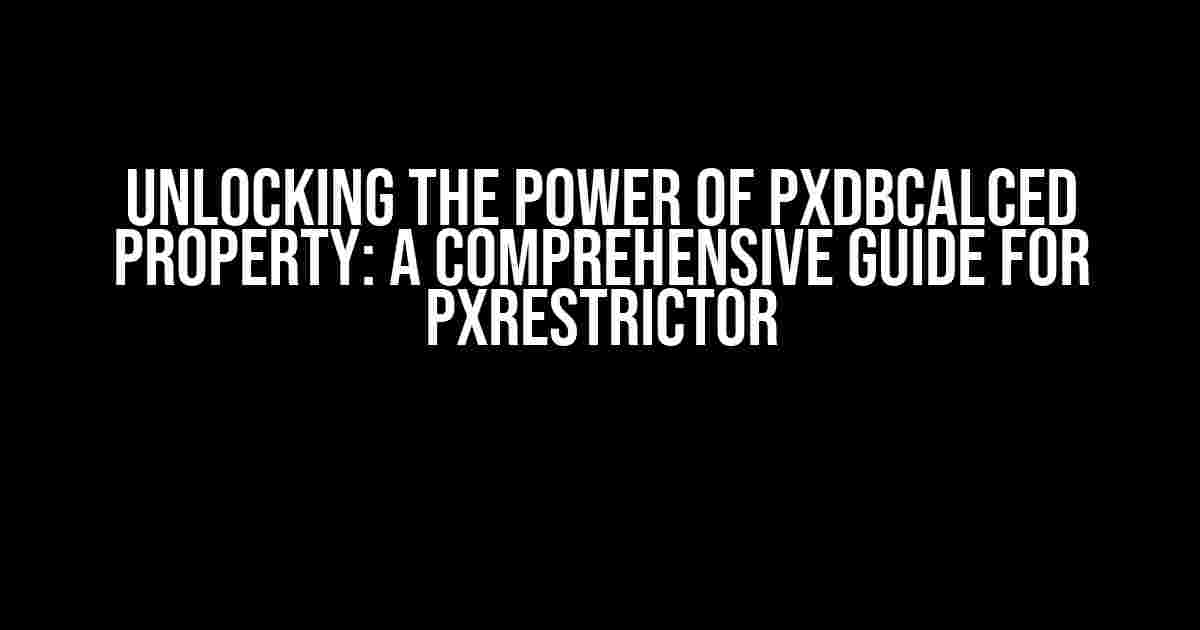In the world of Acumatica, the PXDBCalced property is a game-changer for developers and users alike. When used in conjunction with PXRestrictor, it opens up a realm of possibilities for data calculation and manipulation. But, what exactly is PXDBCalced, and how can you harness its power for your PXRestrictor? In this article, we’ll delve into the world of PXDBCalced, exploring its definition, benefits, and step-by-step instructions for implementation.
What is PXDBCalced Property?
PXDBCalced is a property in Acumatica that allows you to calculate a field’s value based on a custom-defined formula. This property is particularly useful when you need to perform complex calculations or aggregations on data. With PXDBCalced, you can create custom calculations that involve multiple fields, tables, or even external data sources.
Benefits of Using PXDBCalced Property
- Flexibility**: PXDBCalced offers unparalleled flexibility in data calculation, allowing you to create custom formulas that cater to your specific business needs.
- Automation**: By automating calculations, you can reduce manual errors and increase efficiency, freeing up resources for more valuable tasks.
- Scalability**: As your business grows, PXDBCalced enables you to easily adapt and modify calculations to accommodate changing requirements.
How to Use PXDBCalced Property with PXRestrictor
To get started with PXDBCalced, you’ll need to create a custom formula and apply it to a field in your Acumatica system. Here’s a step-by-step guide to help you get started:
Step 1: Create a Custom Formula
public class MyCalculator : PX.Data.IBqlFormula
{
[PXDBCalced(typeof(decimal))]
[PXUIField(DisplayName = "Custom Calculation")]
public decimal? CalcCustomField()
{
// Your custom calculation logic goes here
return (decimal)(this.GetAttributeValue<decimal>("Field1") * this.GetAttributeValue<decimal>("Field2"));
}
}
In this example, we’ve created a custom formula called `CalcCustomField` that calculates the product of two fields, `Field1` and `Field2`. You can modify this formula to suit your specific needs.
Step 2: Apply the Custom Formula to a Field
[PXDBCalced(typeof(MyCalculator))]
public decimal? CustomField { get; set; }
Here, we’ve applied the custom formula to a field called `CustomField`. This field will now display the calculated value based on the formula defined in `MyCalculator`.
Step 3: Configure PXRestrictor
[PXRestrictor(typeof WHERE<MyTable.customField, Equal<>))]
public class MyRestrictor : PX.Data.IBqlRestrictor
{
public static readonly new SqlOperation _Operation = new SqlOperation("CUSTOMFIELD = {0}");
}
In this example, we’ve created a custom restrictor called `MyRestrictor` that filters records based on the `CustomField` calculation. The `{0}` placeholder is replaced with the actual value of the `CustomField`.
Step 4: Apply the Restrictor to a DAC
[PXRestrictor(typeof(MyRestrictor))]
public class MyDAC : PX.Data.IBqlTable<MyDAC>
{
// DAC definition
}
Finally, we’ve applied the custom restrictor to a DAC (Data Access Class) called `MyDAC`. This DAC will now filter records based on the `CustomField` calculation.
Best Practices for Using PXDBCalced Property
To get the most out of PXDBCalced, follow these best practices:
- Keep it simple**: Avoid complex calculations that can impact system performance. Break down complex formulas into smaller, more manageable parts.
- Use caching**: Cache calculated values to improve performance and reduce database queries.
- Test thoroughly**: Test your custom formulas extensively to ensure accuracy and reliability.
- Document your code**: Clearly document your custom formulas and restrictors to ensure easy maintenance and troubleshooting.
Troubleshooting Common Issues
If you encounter issues with PXDBCalced, refer to the following troubleshooting tips:
| Error Message | Solution |
|---|---|
| PXDBCalced property is not calculating correctly | Check your custom formula for errors or typos. Verify that the formula is correctly applied to the field. |
| PXRestrictor is not filtering records correctly | Check the restrictor configuration and ensure that the custom formula is correctly applied to the field. |
| System performance is slow | Optimize your custom formulas and restrictors to reduce database queries and improve performance. |
Conclusion
In conclusion, the PXDBCalced property is a powerful tool that, when used in conjunction with PXRestrictor, can revolutionize the way you calculate and manipulate data in Acumatica. By following the steps and best practices outlined in this article, you can unlock the full potential of PXDBCalced and take your Acumatica development to the next level.
Remember to keep your formulas simple, test thoroughly, and document your code to ensure easy maintenance and troubleshooting. With PXDBCalced, the possibilities are endless – so get creative and start calculating!
Note: The above article is a sample content and needs to be reviewed and edited according to your requirements and style guide before publishing.Here are 5 Questions and Answers about “PXDBCalced property for use in PXRestrictor”:
Frequently Asked Question
Get the answers to your burning questions about PXDBCalced property for use in PXRestrictor!
What is PXDBCalced property used for in PXRestrictor?
PXDBCalced property is used to calculate an expression at the database level, which can then be used as a filter in PXRestrictor. This helps to improve performance by reducing the amount of data that needs to be retrieved from the database.
How do I specify the PXDBCalced property in PXRestrictor?
To specify the PXDBCalced property in PXRestrictor, you need to set the PxDBCalced attribute to True on the field that you want to use as a filter, and then define the calculation expression using the PXDBCalcedReturnType attribute.
What are the benefits of using PXDBCalced property in PXRestrictor?
Using PXDBCalced property in PXRestrictor can improve performance by reducing the amount of data that needs to be retrieved from the database, and can also simplify the development process by allowing you to define complex calculations at the database level.
Can I use PXDBCalced property with other PXRestrictor features?
Yes, you can use PXDBCalced property in combination with other PXRestrictor features, such as PXSelector and PXFilter, to create complex filtering logic and improve the performance of your application.
Are there any limitations to using PXDBCalced property in PXRestrictor?
Yes, there are some limitations to using PXDBCalced property in PXRestrictor, such as limitations on the complexity of the calculation expression and potential issues with data type conversions.
